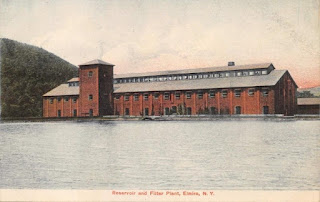by Susan Zehnder, Education Director
 |
| John M. Diven |
The EWC system delivered
water to Southside homes and businesses near the Chemung River. In mid-19th
century America, there were only 83 public water supply systems in existence. Like
Elmira’s, 50 of these were privately operated. It wasn’t that the idea of a reliable
water system was new - its importance had been known since Roman times. It
was a question of who had responsibility for delivering that water.
The
Elmira Water Company had been chartered in 1859, when the NYS legislature
incorporated the company allowing them to raise capital. The area’s population
was growing, and its 7,000 residents were expecting reliable water.
The EWC system relied on gravity to draw water directly from nearby Seeley
Creek, using state-of-the-art wooden pipes from Wyckoff Bros. (later Wyckoff &
Son’s), a company, based on Water Street in Elmira.
Arcalous Wyckoff, owner, engineer, and founder of the successful pipe company, held patents for a specialized boring machine used to make wooden pipes. He was also an initial investor in the water company and lived with his family in an imposing mansion on the Southside. His home is gone now, but is the current location of Fagan Engineers & Land Surveying, a civil engineering company.
Despite
public interest and popularity, the water company faltered. Determined it would
succeed, investors including the Diven family then formed the Elmira Water
Works Company in 1869. They added another system to supply the city’s Northside
and downtown area that would draw water from a Chemung River reservoir near
Hoffman Street.
The Diven
family bought out other investors and became major stakeholders in the company.
They built a 100-million-gallon reservoir on Upper Hoffman Street and added a
pumping line down Water Street to assist during dry spells. John had been
working at the company, and though he didn’t have training in civil engineering,
he was appointed water superintendent in 1875. Under his leadership the company
installed a water pumping station and filter plant.
In 1886, hoping the city would take over operations, the Divens offered the water
company to the City of Elmira for $400,000. The city turned them
down.
Six years later the Municipal Improvement Co. purchased stock in the company and took over
operations. John was kept on as superintendent.
In 1896, the Elmira community battled a terrible typhoid outbreak which resulted in 46 deaths. To prevent future outbreaks, the water company added one of the country’s first mechanical filtration plants, locating it next to the reservoir. It included 18 units of rapid sand filters. This barrier process, newly discovered in the 1890s, helped protect municipal water supplies from contamination and avoided spreading waterborne illnesses. It also required less land for operations.
In 1904, all
the utilities in the Elmira area were consolidated into the Elmira Water,
Light, & Railroad Company. John Diven continued to serve as water
superintendent until 1905, when he left Elmira to take a similar position in Charleston,
South Carolina. He was there for several years before moving to manage the water system of Troy, New
York, for another seven years. During this time, the family suffered the loss of two infant children. Sadly, after moving to New York City to take a break, Susan died in 1921. John married
Charlotte Sophia Edgley in 1922 and they returned to Troy, where he managed the water system until a year before he died in 1925.
In
addition to being water superintendent, Diven owned a furniture company and was
a member of the New York State assembly. He was a founding member of the
American Water Works Association and served in leadership positions until 1924.
In 1973, the National Water Industry Hall of Fame, also known as the Water Utility Hall of Fame, honored John M. Diven as the 15th American to make significant contributions to the field of public water.
A plaque, accepted by his son, was given to the Elmira Water Board to hang in their offices. Today the John M. Diven award from the American Water Works Association is presented yearly to a New York member for outstanding services.
John M.
Diven has two headstones. One is part of the family plot located at nearby
Woodlawn Cemetery. This stone is next to his first wife, Susan, and infant
daughters. A second headstone is in Oakwood Cemetery, Troy, NY, where his second
wife Charlotte is buried. She outlived him by 25 years.



No comments:
Post a Comment